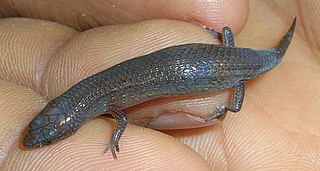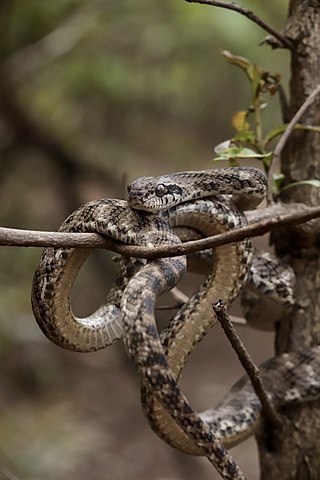
Ristella is a genus of skinks, lizards in the family Scincidae. The genus is endemic to the Western Ghats of southwestern India. Member species are commonly known as cat skinks because of their retractile claws. This genus can be instantly identified by the presence of only four fingers in forelimbs in all the species. All the members look more or less similar, and are drab dark brown to blackish in colouration, with paler undersides. This poorly known group of lizards is diurnal, insectivorous, terrestrial to semi-fossorial in habits. They inhabit deep leaf-litter and grasslands in montane forests and rainforests.

Monilesaurus ellioti, also known commonly as Elliot's forest lizard, is a species of arboreal, diurnal, lizard in the family Agamidae. The species is endemic to the Western Ghats, India.

Agasthyagama beddomii, commonly known as the Indian kangaroo lizard, is a diurnal, terrestrial, insectivorous agamid lizard, endemic to the Western Ghats of South India.

Boiga dightoni, commonly known as Dighton's catsnake, the Pirmad cat snake, and the Travancore cat snake, is a species of rear-fanged mildly venomous snake in the family Colubridae. The species is endemic to the Western Ghats of India.

Boiga forsteni, also known commonly as Forsten's cat snake, is a species of mildly venomous rear-fanged snake in the family Colubridae. The species is endemic to South Asia.
Beddome's day gecko is a species of lizard in the Family Gekkonidae endemic to India.

Eryx johnii is a species of nonvenomous snake in the subfamily Erycinae of the family Boidae. The species is native to Iran, Pakistan, and India. There are no subspecies which are recognized as being valid.

Uropeltis pulneyensis, commonly known as the Indian earth snake and the Palni shieldtail, is a species of snake in the family Uropeltidae. The species is endemic to the Western Ghats of India.

Ophisops beddomei, commonly known as Beddome's snake-eye or Beddome’ s lacerta, is a species of lizard in the family Lacertidae. The species is a diurnal and fast-moving terrestrial lizard, which is endemic to the Western Ghats of India.

Ophisops jerdonii, commonly known as Jerdon's cabrita, Jerdon's snake-eye, and the Punjab snake-eyed lacerta, is a species of lizard in the family Lacertidae. The species is native to South Asia.

Riopa guentheri, commonly known as Günther's supple skink and Günther's writhing skink, is a species of lizard in the family Scincidae. The species is endemic to India.

Eutropis tytleri is a species of skink, a lizard in the family Scincidae. The species is endemic to the Andaman Islands, India.

Ristella beddomii, commonly known as Beddome's cat skink and Beddome's ristella, is a species of skink, a lizard in the family Scincidae. The species is native to southwestern India.
Ristella guentheri, commonly known as Günther's ristella and Gunther's cat skink, is a species of lizard in the family Scincidae. The species is endemic to India.

Ristella travancorica, commonly known as the Travancore cat skink or the Travancore ristella, is a species of skink endemic to the Western Ghats in India.

Sphenomorphus dussumieri, commonly known as Dussumier's forest skink and Dussumier's litter skink, is a species of skink, a lizard in the family Scincidae. The species is endemic to southern India.
Tropidophorus berdmorei, commonly known as Berdmore's water skink, is a species of lizard in the family Scincidae. The species is endemic to Asia.
Thwaites's skink, also known commonly as the fourtoe snakeskink, is a species of skink, a lizard in the family Scincidae. The species is endemic to the island of Sri Lanka.
Nessia burtonii, commonly known as Burton's nessia, Gray's snake skink, or the three-toed snakeskink, is a species of skink, a lizard in the family Scincidae. The species is endemic to the island of Sri Lanka.
Nessia layardi, commonly known as Layard's snake skink or Layard's nessia, is a species of skink, a lizard in the family Scincidae. The species is endemic to the island of Sri Lanka.















